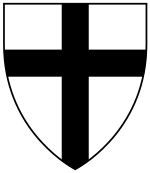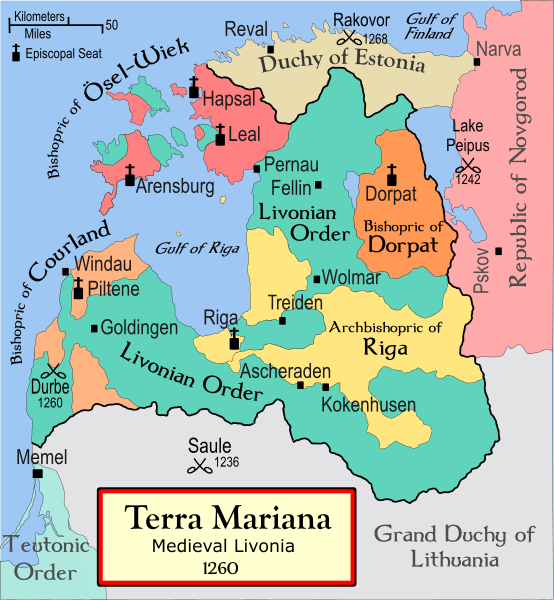


The Battle of the Ice - April 5th - 1242
The Battle
of the Ice (Russian: Ледовое побоище,
Ledovoye poboish'ye; German: Schlacht auf dem Eise; Estonian: Jäälahing; Latvian: Ledus kauja), also known as the
Battle of Lake Peipus (German: Schlacht auf dem Peipussee; Russian: битва на Чудском
озере, bitva na Chudskom ozere), was a battle between the Republic of Novgorod and the Livonian
branch of the Teutonic Knights (whose army consisted mostly of Estonians) on April 5, 1242, at Lake Peipus. The battle is
notable for its having been fought largely on top of the frozen lake.

The battle was a significant
defeat sustained by Roman Catholic crusaders during the Northern Crusades, which were directed against pagans and Eastern
Orthodox Christians rather than Muslims in the Holy Land. The crusaders' defeat in the battle marked the end of their campaigns
against the Orthodox Novgorod Republic and other Russian territories for the next century.
Hoping to exploit the Russians' weakness in the wake
of the Mongol and Swedish invasions, the Teutonic Knights attacked the neighboring Novgorod Republic and occupied Pskov, Izborsk,
and Koporye in the autumn of 1240. When they approached Novgorod itself, the local citizens recalled to the city 20-year-old
Prince Alexander Nevsky, whom they had banished to Pereslavl earlier that year. During the campaign of 1241, Alexander managed
to retake Pskov and Koporye from the crusaders. In the spring of 1242, the Teutonic Knights defeated a detachment of
Novgorodians about 20 km south of the fortress of Dorpat (Tartu). Led by Prince-Bishop Hermann of Dorpat, the knights and
their auxiliary troops of local Ugaunian Estonians then met with Alexander's forces by the narrow strait that connects the
northern and southern parts of Lake Peipus (Lake Peipus proper with Lake Pskovskoe) on April 5, 1242. Alexander, intending
to fight in a place of his own choosing, retreated in efforts to draw the often over-confident Crusaders to the frozen lake.
The crusader forces likely numbered around 4,000. Most
of them were probably Estonians (Chudes). The Russian force in contrast numbered around 5,000 soldiers: Alexander and his
brother Andrei's bodyguards (druzhina), who numbered around 1,000, plus the militia of Novgorod. According to contemporary Russian chronicles, after hours of hand-to-hand fighting, Alexander ordered
the left and right wings of his archers to enter the battle. The knights by this time were exhausted from the constant fighting
and struggling with the slippery surface of the frozen lake. The Crusaders started to retreat in disarray deeper onto the
ice, and the appearance of the fresh Russian cavalry made them run for their lives. When the knights attempted to rally themselves
at the far side of the lake the thin ice started to collapse, under the weight of their heavy armour, and many knights drowned.In
1983, a revisionist view proposed by historian John I. L. Fennell argues that the battle was not as important, nor as large,
as has sometimes been portrayed. Fennell claimed that most of the Teutonic Knights were by that time engaged elsewhere in
the Baltic. He also states that the apparent low casualties endured by the knights according to their own sources are an indicative
of the small magnitude of the encounter.
Russian historian Alexander Uzhankov, who cited a number of authors and
primary sources, suggested that Fennell distorted the picture by ignoring many historical facts and documents. In order to
stress the importance of the battle, he cites two papal bulls of Gregory IX, promulgated in 1233 and 1237, which called for
a crusade to protect Christianity in Finland against her neighbours. The first bull explicitly mentions Russia. The kingdoms
of Sweden, Denmark and the Teutonic Order built up an alliance in June 1238, under the auspicies of Danish king Valdemar II.
They assembled the larger western cavalry force of their time. Another point mentioned by Uzhakov is the 1243 treaty between
Novgorod and the Teutonic Order, where the knights declined all claims over Russian lands. Uzhakov also emphasizes, regarding
the scale of battle, that for each knight deployed on the field there were eight to 30 combatants counting squires, archers
and servants.
According to the Novgorod
First Chronicle, Prince Alexander and all the men of Novgorod drew up their forces by the lake, at Uzmen, by the Raven's
Rock; and the Germans and the Estonians rode at them, driving themselves like a wedge throughout their army. And there was
a great slaughter of Germans and Estonians... they fought with them during the pursuit on the ice seven versts short of the
Subol [north-western] shore. And there fell a countless number of Estonians, and 400 of the Germans, and they took fifty with
their hands and they took them to Novgorod. According to the Livonian
Order's Livonian Rhymed Chronicle, written years later, The [Russians] had many archers, and the battle began with their
bold assault on the king's men [Danes]. The brothers' banners were soon flying in the midst of the archers, and swords were
heard cutting helmets apart. Many from both sides fell dead on the grass. Then the Brothers' army was completely surrounded,
for the Russians had so many troops that there were easily sixty men for every one German knight. The Brothers fought well
enough, but they were nonetheless cut down. Some of those from Dorpat escaped from the battle, and it was their salvation
that they fled. Twenty brothers lay dead and six were captured.
The legacy of the battle, and its decisiveness, rests in that it halted the eastward expansion of the Teutonic Order
and established a permanent border line of the Narva River and Lake Peipus dividing Eastern Orthodoxy from West Catholicism.
The knights' defeat at the hands of Alexander's forces prevented the crusaders from retaking Pskov, the linchpin of their
eastern crusade. The Novgorodians succeeded in defending Russian territory, and the German crusaders never mounted another
serious challenge eastward. Alexander was canonised as a saint in the Russian Orthodox Church in 1574.
